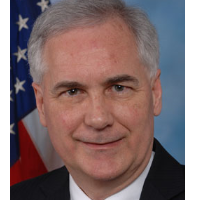Rep. McClintock Argues Minimum Wage Needs to be Low for “Minorities”
 Rep. Tom McClintock
Rep. Tom McClintock
Representative Tom McClintock (R-California) educated C-SPAN viewers last week about the dangers of raising the minimum wage.
The four-term congressman, whose Fourth District encompasses Yosemite National Park, told a “Washington Journal” audience it would “rip the first rung in the ladder of opportunity for teenagers, for minorities, for people who are trying to get into the job market for their first job.” He did not expand upon why he included minorities among those just entering the job market.
This is not 1865.
But he did elaborate on why it would be bad economic policy to offer anything approaching a living wage to the lowest of income earners. And it was as well informed as his insights into race:
“It’s not supposed to support a family. The minimum wage is that first job when you have no skills, no experience, no working history. That’s how you get into the job market, that’s how you develop that experience, develop that work record, get your first raise, then your next raise, then your promotion.”
The U.S. Bureau of Labor Statistics (BLS) indicates he’s less than half right. Most are not teenagers. The BLS report (pdf), “Characteristics of Minimum Wage Workers, 2013,” says half the workers over 16 making minimum wage or less are over the age of 25. Seventeen percent are 45 or older and 3.3% (111,000 workers) are 65 and older.
They are much more likely to be women, but the bureau found little difference between the races. Five percent of black workers topped out at minimum wage, compared to 4% for whites and Latinos and 3% for Asians.
Perhaps there would have been more minorities earning minimum wage or less if more of them were working. The unemployment rate for whites in the U.S. was 4.8% as of December, compared to 10.4% for blacks.
Of the 3.3 million workers striving to make the minimum wage, around 1.5 million are successful. Around 1.8 million are below minimum wage. Nearly two-thirds of all these workers are in a service industry—mostly food preparation—to which society seems comfortable having its denizens toil for a subsistence existence.
But 675,000 people are classified as having sales and office occupations; 38,000 work in construction and extraction occupations; 35,000 work in farming, fishing and forestry; and 21,000 do installation, repairs and maintenance.
California raised its minimum wage to $9 an hour, effective last July, and is scheduled to rise again to $10.10 in January 2016. The U.S. minimum wage is $7.25 and hasn’t changed in five years. Twenty-one states raised their minimum wage levels as of the beginning of this year.
McClintock also expressed his conviction that raising the minimum wage will cost jobs:
“If your labor as an unskilled person just entering the workforce is worth say $7 an hour at a job and the minimum wage is $10, you have just been made permanently unemployable.”
Economists don’t agree with that. More than 600 of them joined an appeal to the President and congressional leadership a year ago to boost the wage and index it to inflation, citing historical data that increases “have had little or no negative effect on the employment of minimum-wage workers.”
“The vast majority of employees who would benefit are adults in working families, disproportionately women,” they wrote.
–Ken Broder
To Learn More:
GOP Rep.: Keep Minimum Wage Low "for Minorities" Who Aren’t Worth More than $7 an Hour (by David Edwards, Raw Story)
Over 600 Economists Sign Letter in Support of $10.10 Minimum Wage (Economic Policy Institute)
Minimum Wage, Factoring for Inflation, is Lower than in 1956 (by Noel Brinkerhoff, AllGov)
Feds Find “Alarming” Minimum-Wage Violations in California and New York (by Ken Broder, AllGov California)
Characteristics of Minimum Wage Workers, 2013 (U.S. Bureau of Labor Statistics) (pdf)
- Top Stories
- Controversies
- Where is the Money Going?
- California and the Nation
- Appointments and Resignations
- Unusual News
- Latest News
- California Forbids U.S. Immigration Agents from Pretending to be Police
- California Lawmakers Urged to Strip “Self-Dealing” Tax Board of Its Duties
- Big Oil’s Grip on California
- Santa Cruz Police See Homeland Security Betrayal in Use of Gang Roundup as Cover for Immigration Raid
- Oil Companies Face Deadline to Stop Polluting California Groundwater





